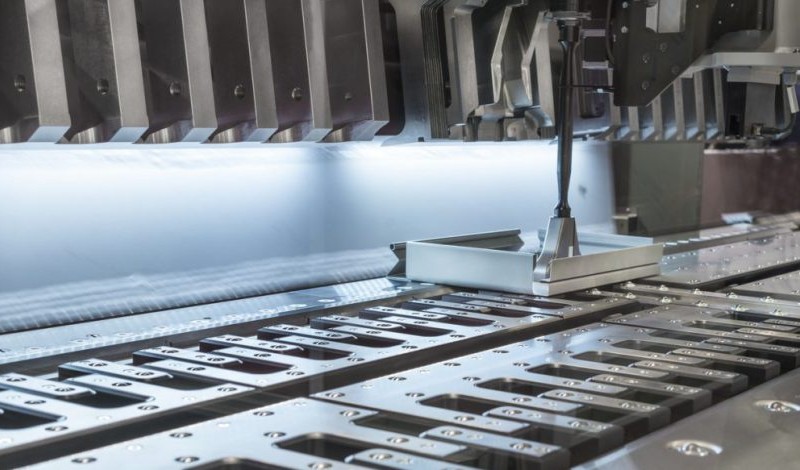Metal Stamping: Innovations Driving Industry Development
Metal Stamping: Innovations Driving Industry Development
Blog Article
Metal Marking Developments: Elevating Production Processes for Superior Results
In the world of manufacturing processes, steel marking has long been a cornerstone technique for producing a selection of accuracy elements. With the unrelenting march of technical advancement, the landscape of steel marking is undertaking a substantial makeover.
Advancement of Steel Stamping Techniques

In addition, developments in product scientific research have brought about the growth of high-strength alloys that can currently be effortlessly marked into elaborate forms, accommodating a more comprehensive variety of commercial applications. The combination of robotics and expert system has even more enhanced the marking procedure by boosting rate and precision while reducing the risk of human error.

Effect of Advanced Materials
Have advanced products changed metal stamping processes significantly in the production market? The answer is a resounding yes (Metal Stamping). The combination of advanced products has actually reinvented metal marking, allowing makers to achieve greater precision, raised effectiveness, and enhanced item top quality. By making use of materials such as high-strength alloys, advanced composites, and cutting-edge coverings, steel stamping processes can currently create components that are lighter, stronger, and extra sturdy than ever in the past.
These sophisticated materials use premium mechanical residential properties, deterioration resistance, and thermal stability, allowing producers to fulfill the needs of modern industries such as aerospace, automobile, and electronics. Furthermore, using advanced materials in metal stamping has helped with the production of intricate geometries and elaborate designs that were previously unattainable through conventional techniques.
Furthermore, the application of sophisticated materials has resulted in decreased material waste, reduced manufacturing prices, and much shorter preparations, making metal stamping processes much more sustainable and economical. As technology remains to breakthrough, the impact of innovative products on metal stamping procedures is anticipated to drive further advancement and enhance the competitiveness of suppliers in the worldwide market.
Automation in Steel Stamping
The advancement of metal stamping procedures driven by the assimilation of advanced products has actually set the phase for considerable developments in automation within the production sector. Automation in metal stamping has actually revolutionized production procedures, improving effectiveness, precision, and total outcome quality. Through the usage of robotics, sensors, and computer-controlled systems, jobs that were as soon as manual and time-consuming can now be performed with unparalleled speed and accuracy.
Automation in metal stamping not only increases production rates yet also guarantees uniformity in the production procedure. By reducing human treatment, the danger of mistakes is substantially reduced, bring about greater degrees of product harmony and reliability. In addition, automation allows manufacturers to embark on complex marking tasks that would certainly be not practical or challenging to accomplish manually.
In addition, automation in steel stamping adds to a safer working environment by minimizing the demand for workers to take part in harmful or repetitive jobs - Metal Stamping. This shift in the direction of automation not only boosts performance however likewise leads the way for the future of manufacturing, where modern technology plays a central role in driving functional quality
Quality Assurance and Inspection Equipments
With an emphasis on precision and integrity, high quality control and assessment systems play a critical function in guaranteeing item quality in metal marking processes. These systems are created to keep track of every phase of manufacturing, from material assessment to the end product, to guarantee that all components fulfill the called for standards. By implementing sophisticated modern technologies such as optical inspection systems, coordinate measuring makers (CMM), and automated determining tools, manufacturers can spot even the tiniest discrepancies in measurements, surface area top quality, and total integrity of stamped components.

Sustainability Practices in Steel Stamping
Building upon the structure of precision and dependability developed with high quality control and examination systems, the integration of sustainable practices in steel marking procedures is significantly ending up being a prime focus for manufacturers seeking to minimize ecological influence and optimize source application. Sustainability methods in steel marking include a variety of campaigns intended at reducing waste generation, energy intake, and greenhouse gas discharges throughout the production process.
One trick facet of sustainability in steel marking is the fostering of green materials and technologies that advertise recyclability and waste reduction. By utilizing recycled products and executing energy-efficient machinery, suppliers can reduce their carbon impact and add to a much more sustainable manufacturing cycle. In addition, enhancing production processes to minimize product waste and power usage not only profits the setting but also results in set you back financial savings for companies in the lengthy run.
Furthermore, the implementation of sustainable techniques in steel marking can improve brand track record and interest environmentally mindful consumers. As sustainability continues to acquire significance in the manufacturing sector, integrating eco-friendly campaigns right into metal stamping processes is important for lasting success and competition on the market.
Conclusion
Finally, steel stamping strategies have significantly developed gradually, integrating advanced products and automation to enhance producing procedures. Quality control and inspection systems play a vital function in ensuring remarkable outcomes, while sustainability techniques are increasingly being carried out to decrease ecological influence. These innovations in metal marking have reinvented the index sector, resulting in extra reliable and lasting production techniques for different markets.
Metal stamping, when a handbook and labor-intensive procedure, has actually changed into an extremely automated and advanced method of shaping steel sheets right into numerous types and styles.Have sophisticated materials transformed metal marking processes considerably in the manufacturing industry? By making use of products such as high-strength alloys, advanced composites, and cutting-edge coverings, metal marking procedures can now produce components that are lighter, stronger, and extra sturdy than ever in the past.
The advancement of steel marking procedures driven by the assimilation of innovative products has actually established the phase for considerable advancements in automation within the manufacturing market.In conclusion, metal stamping strategies have considerably developed over time, incorporating advanced products and automation to enhance producing processes.
Report this page